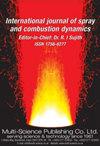Incompressible versus compressible large eddy simulation for the identification of premixed flame dynamics
IF 2.1
4区 工程技术
Q3 ENGINEERING, MECHANICAL
International Journal of Spray and Combustion Dynamics
Pub Date : 2023-03-01
DOI:10.1177/17568277231154204
引用次数: 0
Abstract
The present work compares the respective advantages and disadvantages of compressible and incompressible computational fluid dynamics (CFD) formulations when used for the estimation of the acoustic flame response. The flame transfer function of a turbulent premixed swirl-stabilized burner is determined by applying system identification (SI) to time series data extracted from large eddy simulation (LES). By analyzing the quality of the results, the present study shows that incompressible simulations exhibit several advantages over their compressible counterpart with equal prediction of the flame dynamics. On the one hand, the forcing signals can be designed in such a way that desired statistical properties can be enhanced, while maintaining optimal values in the amplitude. On the other hand, computational costs are reduced and the implementation is fundamentally simpler due to the absence of acoustic wave propagation and corresponding resonances in the flame response or even self-excited acoustic oscillations. Such an increase in efficiency makes the incompressible CFD/SI modeling approach very appealing for the study of a wide variety of systems that rely on premixed combustion. In conclusion, the present study reveals that both methodologies predict the same flame dynamics, which confirms that incompressible simulation can be used for thermoacoustic analyses of acoustically compact velocity-sensitive flames.识别预混火焰动力学的不可压缩与可压缩大涡模拟
本文比较了可压缩和不可压缩计算流体动力学(CFD)公式用于火焰声响应估计时各自的优缺点。通过对大涡模拟(LES)中提取的时间序列数据进行系统识别,确定了湍流预混旋流稳定燃烧器的火焰传递函数。通过对结果质量的分析,本研究表明,在火焰动力学预测方面,不可压缩模拟比可压缩模拟有几个优势。一方面,强迫信号可以设计成这样一种方式,即可以增强所需的统计特性,同时保持振幅的最佳值。另一方面,由于火焰响应中没有声波传播和相应的共振,甚至没有自激声振荡,因此降低了计算成本,从根本上简化了实现。这种效率的提高使得不可压缩CFD/SI建模方法对各种依赖预混燃烧的系统的研究非常有吸引力。总之,本研究表明,两种方法预测相同的火焰动力学,这证实了不可压缩模拟可以用于声致密速度敏感火焰的热声分析。
本文章由计算机程序翻译,如有差异,请以英文原文为准。
求助全文
约1分钟内获得全文
求助全文
来源期刊

International Journal of Spray and Combustion Dynamics
THERMODYNAMICS-ENGINEERING, MECHANICAL
CiteScore
2.20
自引率
12.50%
发文量
21
审稿时长
>12 weeks
期刊介绍:
International Journal of Spray and Combustion Dynamics is a peer-reviewed open access journal on fundamental and applied research in combustion and spray dynamics. Fundamental topics include advances in understanding unsteady combustion, combustion instability and noise, flame-acoustic interaction and its active and passive control, duct acoustics...
 求助内容:
求助内容: 应助结果提醒方式:
应助结果提醒方式:


